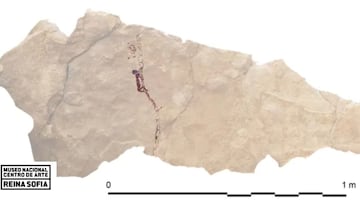Historical discovery: the oldest work of art in the world
A new research technique has helped push the dating of some of the world’s oldest paintings past the 50,000 year barrier.

The scienc journal Nature has announced the discovery of the oldest cave painting in the world, dating back 51,200 years found in a cave on the island of Celebes, Indonesia. It is a drawing of humans hunting a wild pig, which indicates that scenes composed of people and animals in art have an even older origin than previously thought.
One of the most difficult tasks for scientists is dating the origins of rock art. In 2018, the archaeologist Maxime Aubert, a specialist in archaeological sciences at Griffith University in Australia and one of those responsible for the publication in the Nature magazine, found in Borneo, Indonesia the oldest figurative painting of animals, dated 40,000 years old. In the following year, 2019, there was another painting that was deemed at the time to be even older at around 44,000 years on another island in Indonesia.
More precise laser technique has improved sample analysis
However, currently, thanks to a more precise laser method they have been able to discover that the paintings discovered are even older. For example, the one from 2019 is at least 48,000 years old and the one from 2018 is even older: more than 50,000 years old. This marks “the first time we’ve passed the 50,000-year barrier,” said the scientist.
This new technique is called laser-ablation U-series (LA-U-series) incorporates a laser to analyze minute detail and obtain better calculations which are more precise and efficient. This fact implies that smaller samples are necessary, damaging therefore less to the works. Additionally, “our new LA-U-series technique is more accurate,” explains Aubert.
This method can be applied to other paintings and possibly in other geological contexts such as sandstone. “It will revolutionise rock art dating,” said the professor at Griffith University.
Paintings as the oldest way of telling stories
Rock art is one of the oldest forms of storytelling, regardless of whether it represents hunting or another event. The ability to tell stories is a fundamental characteristic in human evolution. The first images known to be made by humans date back 100,000 years are located in South Africa. They are simple lines and patterns made with ochre.
Narrative art was believed to have arisen in Europe first but with the discoveries in Indonesia, it was proven that this was not the case. However, there is still a “huge gap” Aubert admits between those in South Africa and Indonesia.
“Why is it not everywhere?” he asks. However, he is confident that there will be future discoveries: “It’s probably just a matter of time before we find samples that are older.”
In Europe, the oldest animal paintings are those from the French Chauvet Cave, which are more than 30,000 years old. These latest findings bring to light the question of whether the inhabitants of Asia and Europe invented symbolic art each on their own or if those who conquered the world from Africa were already artists who told stories through of pictures.
“It is a paradigm shift, we are moving from Eurocentrism to thinking about other possibilities,” said Diego Gárate, a professor of prehistory at the University of Cantabria in Spain, who did not participate in the study, regarding the Indonesian works found in recent years. Now for scientists the idea lies in knowing which people were the ones who made these figures or knowing a little more about them.
At all times, scientists have emphasized continuing research, because at any time a new discovery can provide new data that gives a twist to the theories held until now. “Humans have probably been telling stories for much longer than 51,200 years,” said Adhi Agus Oktaviana, an Indonesian rock art specialist from the National Research and Innovation Agency (BRIN) in Jakarta who led the team.





